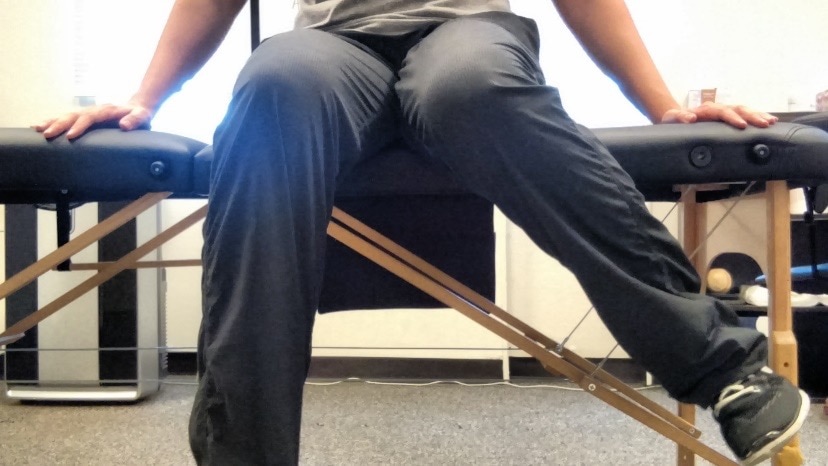Dominating the Court: Adding Power, Improving Your Backhand
Feb 06, 2017Your hip and spinal rotation are the power house of each stroke. The winding-up and subsequent uncoiling of the kinetic chain allows tennis players to add velocity to their stroke. Without the ability to fully rotate the spine side-to-side, much of the torque will be dispersed down to the hips and knees or up through the shoulder and elbows. So if you have nagging aches and pains in those areas, your lack of rotation could be the issue. Let’s check out the amount of hip and thoracic rotation that you have side-to-side.
Hips
When checking internal rotation, sit on a table or box so that your feet are not in contact with the ground. Internal rotation is the motion when your foot moves outward from your body when your hips and knees are bent. We like to see 40-45 degrees, as in the picture below. Be sure that as you rotate your hip, you don’t bring your booty off the table and lean to make it go further! Limited here? Try out the mobility exercise for internal rotation. Always retest your rotation afterward so you know if the mobilization is valuable!

External rotation would be the opposite, so as if you were crossing one leg over the other the ankle resting on the thigh of the other leg. If this is tough, your external rotation may be limited. This is less common but still possible! The best mobility piece for this is the Lateral Hip Release (video below). Try it out! Remember, test- mobility- retest.
If you sit a lot throughout the day or just generally have tight hip flexors, this could impede your ability to extend your hips fully. My favorite go-to for this is the Couch Stretch (video below). Most people would benefit from spending 2 minutes in this stretch daily. It will undoubtedly add power to your strokes and serves!
I would not be shocked to see that most tennis players will have a greater amount of rotation or more ease of rotation to their forehand side (so left rotation in right handed athlete). This is a structural change that can happen over time as muscle for rotation in one direction are recruited more frequently that muscles for rotation the opposite way. But what about the backhand? If you feel that you lose a lot of power with the backhand stroke, it could be due to a rotation restriction.
Take a look at your spinal rotation mobility to each side. Laying on your side, knees up at 90 degrees, rotate your back to the floor so that your arms make a T. The top knee should stay stacked on the bottom and both shoulder should touch the floor. If this is challenging, we modify this just a bit to an exercise working on spinal rotation throughout the whole movement: The Windmill (video below). With this variation, you can use breathing to gain a bit more range and get the shoulder closer to the floor. If you get stuck with your arm overhead and you are unable to touch the hand to the floor, then pause there, take a deep breath and on the exhale gently push into a bit more rotation.
To incorporate hip extension and thoracic rotation, I suggest adding scorpions (video below) to your mobility routine. They will also hit the shoulder with a nice stretch across the front. If you’re short on time- hit a set of 10 to each side before grabbing the racquet!
Notice that although we are adding power to your stroke, there were no strengthening specific exercises. The first step is to chip away at long standing range of motion deficits you have may have. Having proper hip range and spinal rotation will allow you to unleash your potential from the power house of the body. Once range of motion has been addressed, other areas to explore are strength and control. However, skipping the mobility piece will only allow you to layer on strength in the shortened range of motion. To be resilient, mobilize then strengthen!
Thanks for reading,
Dr. Jackie, PT, DPT, OCS, CSC
Let us help you figure out to live your best active life today!
Remember, Movement is Medicine!

